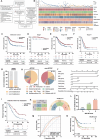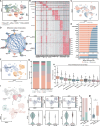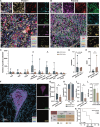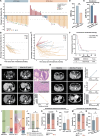Blood Biomarker-Based Predictive Indicator for Liver Metastasis in Alpha-Fetoprotein-Producing Gastric Cancer and Multi-Omics Tumor Microenvironment Insights
- PMID: 40433893
- PMCID: PMC12302549
- DOI: 10.1002/advs.202503499
Blood Biomarker-Based Predictive Indicator for Liver Metastasis in Alpha-Fetoprotein-Producing Gastric Cancer and Multi-Omics Tumor Microenvironment Insights
Abstract
Alpha-fetoprotein-producing gastric cancer (AFPGC) is a rare but highly aggressive subtype of gastric cancer. Patients with AFPGC are at high risk of liver metastasis, and the tumor microenvironment (TME) is complex. A multicenter retrospective study is conducted from January 2011 to December 2021 and included 317 AFPGC patients. Using a multivariable logistic regression model, a nomogram for predicting liver metastasis is built. By combining AFP and the neutrophil-lymphocyte ratio (NLR), we developed a novel and easily applicable predictive indicator, termed ANLiM score, for liver metastasis in AFPGC. An integrated multi-omics analysis, including whole-exome sequencing and proteomic analysis, is conducted and revealed an immunosuppressive TME in AFPGC with liver metastasis. Single-cell RNA sequencing and multiplex immunofluorescence identified the potential roles of tumor-associated neutrophils and tertiary lymphoid structures in shaping the immune microenvironment. These findings are validated in a real-world cohort receiving anti-programmed cell death 1 (anti-PD-1) therapy, which showed concordant effectiveness. In addition, the ANLiM score is also identified as a promising biomarker for predicting immunotherapy efficacy. Overall, a blood biomarker-based predictive indicator is developed for liver metastasis and immunotherapy response in AFPGC. The findings on immune microenvironmental alterations for AFPGC with liver metastasis provide new insights for optimizing immunotherapy strategies.
Keywords: alpha‐fetoprotein‐producing gastric cancer; immunotherapy; liver metastasis; tumor microenvironment.
© 2025 The Author(s). Advanced Science published by Wiley‐VCH GmbH.
Conflict of interest statement
The authors declare no conflict of interest.
Figures





Similar articles
-
Comparison of Two Modern Survival Prediction Tools, SORG-MLA and METSSS, in Patients With Symptomatic Long-bone Metastases Who Underwent Local Treatment With Surgery Followed by Radiotherapy and With Radiotherapy Alone.Clin Orthop Relat Res. 2024 Dec 1;482(12):2193-2208. doi: 10.1097/CORR.0000000000003185. Epub 2024 Jul 23. Clin Orthop Relat Res. 2024. PMID: 39051924
-
Systemic treatments for metastatic cutaneous melanoma.Cochrane Database Syst Rev. 2018 Feb 6;2(2):CD011123. doi: 10.1002/14651858.CD011123.pub2. Cochrane Database Syst Rev. 2018. PMID: 29405038 Free PMC article.
-
Are Current Survival Prediction Tools Useful When Treating Subsequent Skeletal-related Events From Bone Metastases?Clin Orthop Relat Res. 2024 Sep 1;482(9):1710-1721. doi: 10.1097/CORR.0000000000003030. Epub 2024 Mar 22. Clin Orthop Relat Res. 2024. PMID: 38517402
-
[Exploration of biomarkers for the efficacy of anti-PD-1 immunotherapy in patients with gastric cancer peritoneal metastasis].Zhonghua Zhong Liu Za Zhi. 2025 Jun 23;47(6):525-532. doi: 10.3760/cma.j.cn112152-20240826-00368. Zhonghua Zhong Liu Za Zhi. 2025. PMID: 40069088 Chinese.
-
Systemic pharmacological treatments for chronic plaque psoriasis: a network meta-analysis.Cochrane Database Syst Rev. 2021 Apr 19;4(4):CD011535. doi: 10.1002/14651858.CD011535.pub4. Cochrane Database Syst Rev. 2021. Update in: Cochrane Database Syst Rev. 2022 May 23;5:CD011535. doi: 10.1002/14651858.CD011535.pub5. PMID: 33871055 Free PMC article. Updated.
Cited by
-
The supplementary value of the neutrophil-to-lymphocyte ratio in the diagnosis of rheumatoid arthritis.Medicine (Baltimore). 2025 Jul 18;104(29):e43048. doi: 10.1097/MD.0000000000043048. Medicine (Baltimore). 2025. PMID: 40696582 Free PMC article.
References
Publication types
MeSH terms
Substances
LinkOut - more resources
Full Text Sources
Medical
